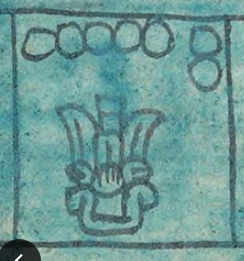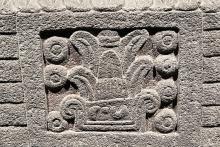Chicome Acatl (Mdz2r)
This representation of the solar year (xihuitl) date Seven Reed (Chicome Acatl or Chicomacatl) consists of the notation for seven (chicome) and the simplex glyph for reed (acatl). The number seven is expressed as seven small circles grouped into five (along the top from the upper left corner) and two (down the right side from the upper right corner). The ones doe not have dots or smaller concentric circles; they are empty, except for paint. For comparisons, see below. The reed is presented as an upright cane standing in a symbolic, cross-sectioned waterway (apantli) and decorated with feathers the way arrows are decorated. The entire date is boxed in with a black-line drawing, and it is painted over with a turquoise blue.
Stephanie Wood
A boxed-in date says this refers to a year. The turquoise (xihuitl) wash is a reminder that this is a year (xihuitl), given that this blue and the word for year are homophoneos. Here, the ones are presented something like a math equation, 5 + 2 = 7. The groupings harken back to when numbers were counted on the fingers and toes, with five being on one hand and then two more fingers.
Stephanie Wood
c. 1541, or by 1553 at the latest
dates, fechas, calendars, calendarios, números, cañas, carrizos, flechas, plantas, plumas, canales, xiuhpohualli, año, turquesa, xihuitl, feathers
This example of a carved stone hieroglyph representing the date Chicome Acatl (Seven Reed, or 7-Reed) has a couple of details that it shares with the example from the Codex Mendoza’s glyph for the same date (above), such as the feathers and what may be an apantli (canal, with the frame that curls left and right on the top edges), such as the one in the glyph for Atonal, https://aztecglyphs.wired-humanities.org/content/atonal-mdz7v. The stone carving is located on the Templo Calendárico at the Tlatelolco archaeological site. Photo by R. Haskett, 2 May 2025.

chicome, seven, https://nahuatl.wired-humanities.org/content/chicome
acatl, reed, https://nahuatl.wired-humanities.org/content/acatl
chicomacatl, a medicinal plant, also a calendrical name, Seven-Reed or 7-Reed, https://nahuatl.wired-humanities.org/content/chicomacatl
Siete-Caña, o 7-Caña
Stephanie Wood
Codex Mendoza, folio 02 recto, https://digital.bodleian.ox.ac.uk/objects/2fea788e-2aa2-4f08-b6d9-648c00..., image 14 of 188.
The Bodleian Libraries, University of Oxford, hold the original manuscript, the MS. Arch. Selden. A. 1. This image is published here under the UK Creative Commons, “Attribution-NonCommercial-ShareAlike 3.0 License” (CC-BY-NC-SA 3.0).







